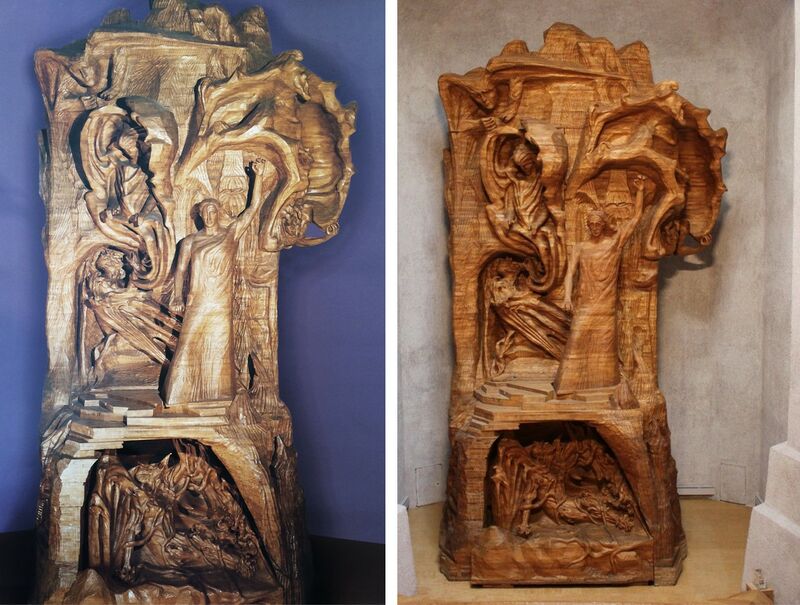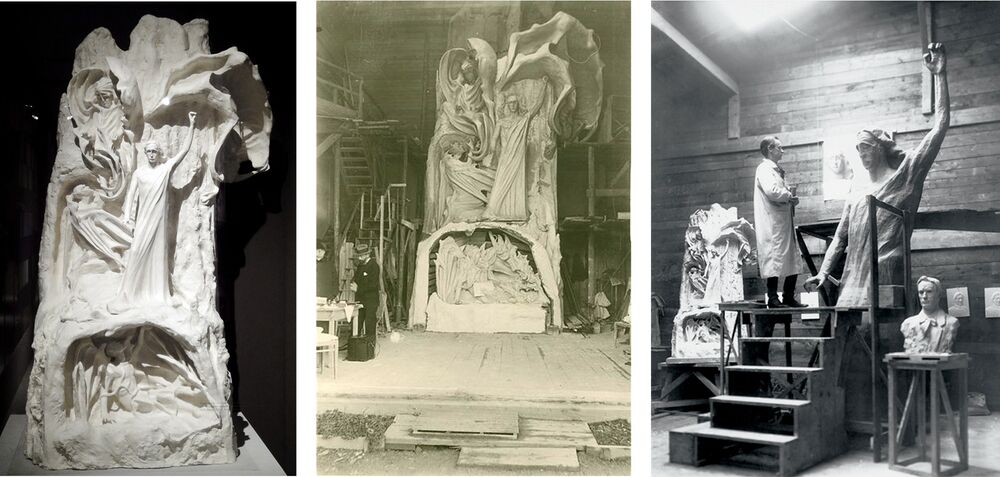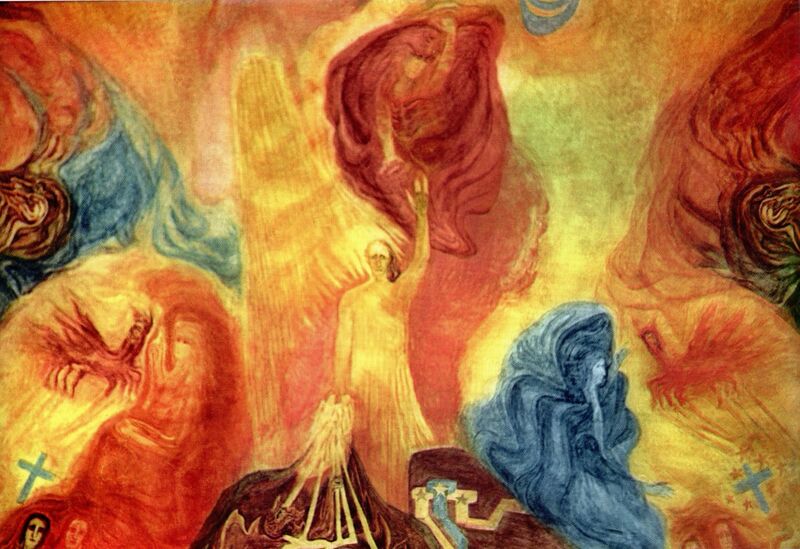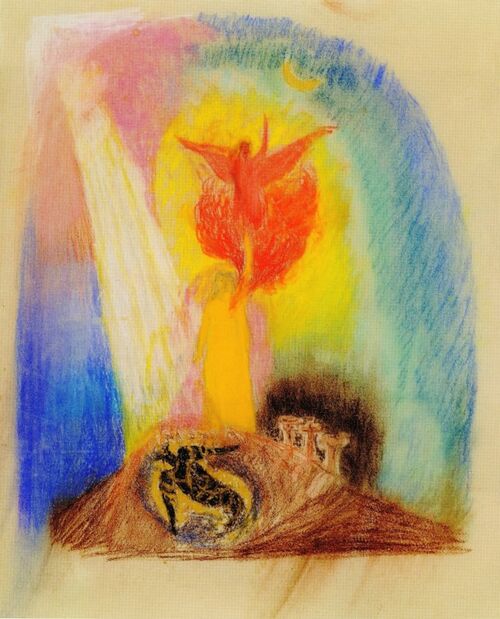Representative of humanity
The Representative of Humanity is a nine meters high wooden sculpture created by Rudolf Steiner between 1917 and 1925 in a collaboration with Edith Maryon.
It was placed in a central place in the first Goetheanum, was saved from the fire when the Goetheanum was destroyed by arson, and is now placed in the second Goetheanum.
It depicts the Christ in a human representation, as the representative of Man - the human being, providing the balanced mid-way of elemental balance and the human soul's battle between Luciferic and Ahrimanic influences represented by Ahriman in the cave and Lucifer on top.
Aspects
- Luciferic and Ahrimanic polarities and illness
- Werner Priever wrote that "Rudolf Steiner led physicians who visited Dornach to his wooden sculpture and designated the two shapes of Lucifer and Ahriman as imaginations of the two polar processes of disease, the sclerotizing and the inflammatory illnesses. In other contexts he spoke of neurasthenia and hysteria as the two polarities to which all illnesses incline and whose form of appearance is similarly imbued with Ahrimanic and Luciferic forces and impulses." (reference, see The double#1982 - Werner Priever)
- see also:
Illustrations
FMC00.301 depicts the Representative of humanity sculpture
FMC00.301A shows the placement in the original first and current Goetheanum (click to enlarge)
FMC00.301B shows the plaster model and, on the right, Rudolf Steiner in 1919.
Schema FMC00.301C: shows the countenance of the symbolic (so not purely physical) representation of Christ-Jesus in Rudolf Steiner's sculpture Representative of Humanity, as described a.o. in the lecture of 1915-05-18-GA159 and also by Marie Steiner in her 1932 essay 'In Memory of Rudolf Steiner'.
For more info on physical appearance, see also Three years of Christ Jesus.
FMC00.344 is a painting by Gerard Wagner of the Slavic motif of the representative of humanity between Ahriman and Lucifer (see references)
FMC00.344A is an original picture giving a partial view on the paintings of the small cupola of the first Goetheanum
FMC00.344B is a pastel sketch by Gerard Wagner of the middle motif of the representative of humanity between Ahriman and Lucifer (see references in 'Further reading' section below).
Lecture coverage and references
1915-05-18-GA159
introduction to the lecture:
In 1914, Rudolf Steiner had begun a scaled-down model of the Christ sculpture that was later to be installed in the Goetheanum.. As the work on the sculpture itself began, he frequently explained its significance in his lectures.
One of Rudolf Steiner's lecture tours, May 6 through May 18, 1915, took him to Vienna, Prague and Linz. In all three cities he stressed that the Christ figure in the sculptured group would have to be portrayed as a being in equipoise between the polar forces of Lucifer and Ahriman and that this being was symbol of, and model for, man's own existence here on earth. The Linz lecture, which is here translated, presents the group in a world-historical context and relates the significance of the Lucifer-Christ-Ahriman configuration to the events surrounding World War I. Steiner sees a parallel between Christ's central, but equalizing position and Central Europe's mission in World War I. He implies that Germany's and Austria's militarism and political intransigence alone did not lead to war against the world powers in the East (Russia) and the West (France, England and, since 1917, the United States). According to Steiner, World War I was the earthly expression of a struggle between luciferic forces in the East and ahrimanic forces in the West, and it was Central Europe's destiny to mediate between these forces.
quote
Some day when the building in Dornach that is dedicated to the spiritual sciences is completed, it will contain, in a significant spot, a sculpture dominated by three figures. In the center of this group a figure will tower as if it were the manifestation of what I would call the most sublime human principle ever to unfold on earth. Hence, one will be able to experience this representation of the highest human principle in the evolution of the earth-the Christ, who in the course of this evolution lived three years in the body of Jesus of Nazareth. A special task in the portrayal of this Christ figure will be to make two ideas visible. Firstly, it will be important to show how the being that we are concerned with dwells in a human body. Secondly, it must also become apparent how this human body, in every facial expression and in every gesture reflects a magnificent degree of spiritual refinement, which descended with the Christ from cosmic and spiritual heights into this body in its thirtieth year. Then there will be the remaining two figures of the group, one to the left and the other to the right of the Christ figure, if that is the proper name for the figure that I have just sketched. This Christ figure is placed in such a way that it seems to be standing in front of a rock that towers noticeably at His left side, with its peak extending over His head. On top of the rock there will be another figure, winged but with his wings broken, who for this reason begins to fall into the abyss. One feature in the Christ figure that must be worked out with special artistic care is the manner in which he raises his left arm, for it is precisely this gesture that precipitates the breaking of the wings. It must not appear, however, as if the Christ Himself were breaking the wings of this being. Rather, the interaction of the two figures must be portrayed artistically to show how the Christ, by the very motion of raising his hand, is expressing his infinite compassion for this being. Yet this being cannot bear the energy flowing upward through arm and hand, an energy that is evidenced by indentations that the fingers of the extended hand seem to leave in the rock itself. When this being comes into proximity with the Christ being, he feels something that may be expressed in the words: I cannot bear the radiation of such purity upon me.
This feeling dominates so essentially as to break this upper beings wings and cause his imminent plunge into the abyss. To make this visible will be a particularly important artistic task and you will see how the meaning of this interaction could easily be misunderstood. Imagine, for example, an artistic portrayal of the Christ suggesting that merely by raising His hand He would radiate such power onto the being that his wings would be broken, forcing the plunge into the abyss. In that case it would be the Christ Himself who irradiated this being, as it were, with hatred, and thereby caused his descent. Such an impression must under no circumstances be conveyed. Rather, the being must be portrayed as having caused his own fall, for what is to be shown plunging downward, with broken wings, is Lucifer.
Now let us consider the other side of the group, toward the right of the Christ figure. There, the rock will have a ledge and, therefore, will be concave underneath. In this depression there will be another winged figure, who with his arm-like organs turns toward the ledge above. You have to visualize this as follows. To the right is the depression in the rock and in it stands this winged figure with wings entirely different from the figure on top of the rock. The wings of the figure on top of the rock resemble those of an eagle, whereas the figure in the depression has bat-like wings. This figure virtually buries himself in the cave, working in shackles, ever busy undermining the earthly realm.
The Christ figure in the middle has his right hand directed downward and the left one upward. Again, it will be an important artistic task not to show the Christ as wanting to shackle this figure; rather, he has infinite compassion for this being, which is Ahriman. Ahriman cannot bear this compassion and he writhes with pain from what the hand of the Christ exudes. This radiance from Christ's hand causes the golden veins down in the rock depression to wind around Ahriman's body like strong cords and shackle him. What is happening to Lucifer is his own doing; the same is true with Ahriman. This concept is going to take form as a sculpture that will be set up in a significant place in the new building. Above the sculptured group we will attempt to express the same motif through the medium of painting, but then the concept must be expressed differently. To summarize, the group of three figures: Christ, Lucifer and Ahriman will stand at the bottom as a sculpture, and above, the same motif will appear as a painting.
We are injecting this configuration of a relationship between Christ, Lucifer and Ahriman into our Dornach building because the science of the spirit reveals to us in a certain way that the next task regarding the comprehension of the Christ impulse will be to make man finally understand how the three forces of Christ, Lucifer and Ahriman are related in this world. To this day there has been much talk about Christianity and the Christ impulse, but man has not yet gained a clear understanding of what the Christ impulse has brought into the world as the result of the Mystery of Golgotha. Certainly, it is generally admitted that there is a Lucifer or an Ahriman, but in so doing, it is made to appear that from these two one must flee, as if one wished to say, “I want nothing to do with Lucifer and Ahriman!” — In yesterday's public lecture <1 I described the way in which the divine-spiritual forces can be found. If these forces did not want to have anything to do with Lucifer and Ahriman, either, the world could not exist. One does not gain the proper relationship to Lucifer and Ahriman by saying, “Lucifer, I flee from you! Ahriman, I flee from you!” Rather, everything that man has to strive for as a result of the Christ impulse must be seen as similar to the equilibrious state of a pendulum. In the center, the pendulum is in perfect balance, but it must oscillate to one side or the other. The same applies to man's development here on earth. Man must oscillate to the one side according to the luciferic principle and to the other according to the principle of Ahriman, but he must maintain his equilibrium through the cultivation of Paul's declaration, “Not I, but Christ in me.”
1915-06-13-GA159
It is quite indifferent what name we give to this central figure, but we may see in it the representative of Man on earth, man's representative in the highest meaning of the word. And if we see the ideal of humanity in that human being who for three years bore within him the Christ, then we may also see the Christ in this central figure of our plastic group.
Yet we should not simply face the statue with the thought: “That is meant to be the Christ”, for this would be wrong.
Instead, we should experience everything in an artistic way, that is to say, we should not interpret things symbolically from outside, but everything should result from what the forms themselves reveal.
1919-12-13-GA194
It is in this sense that modern man must come to understand, through his feeling, the ancient Apollo-saying: “Know thou thyself.” But “Know thou thyself” not in some abstract way; “Know thou thyself in the struggle for balance.”
Therefore we have to set up at the east end of the building what is intended to cause the human being to feel this struggle for balance. That is to be represented in the plastic wood group mentioned yesterday, with the Christ-Form as the central figure — the Christ-Form which we have tried to fashion in such a way that one may imagine: It was really thus that the Christ went about in Palestine at the beginning of our era in the man Jesus of Nazareth.
The conventional pictures of the bearded Christ are actually only creations of the fifth or sixth century, and they are really not in any way true portraits, if I may use the expression. That has been attempted here: to produce a true portrait of Christ, Who is to be at the same time the Representative of the seeking human being, the human being striving for balance.
You will see then in this group two figures: here the falling Lucifer, here the upward-striving Lucifer; here below, connected with Lucifer, as it were, an Ahrimanic form, and here a second Ahrimanic form. The Representative of Humanity is placed between the Ahrimanic form — the philistine, the insipid, the aridly materialistic — and the Lucifer-form — the ecstatic, the fantastic; between the Ahriman-figure — all that leads to petrifaction, to sclerosis — and the Lucifer-figure — the representation of all that leads man feverishly out beyond the limit of what his health can endure.
After we have placed in the center, as it were, the Gothic cathedral, which encloses no image, but either the relics of saints or even the Holy Grail — that is, something no longer directly connected with beings living on earth — then we come back again, I might say, to the idea of the building as enclosing something, but now enclosing the being of man in his struggle for balance.
If destiny permits it, and this building can some day be completed, he who sits within it will have directly before him, while he is looking upon the Being who gives meaning to the earth evolution, something which suggests to him to say: the Christ-Being. But this is to be felt in an artistic way. It must not be merely reasoned about speculatively as being the Christ, but it must be felt. The whole is artistically conceived, and what comes to artistic expression in the forms is the most important part. But it is nevertheless intended to suggest to the human being through feeling — I might say to the exclusion of the intellect, which is to be merely the ladder to feeling — that he is to look toward the east of the building and be able to say: “That art thou.” But now, not an abstract definition of man, for balance can be effected in innumerable ways. Not an image of a god is enclosed, for it is true for Christians also that they are to make no image of a God — not an image of a god is enclosed, but that is enclosed which has developed of the qualities of the human group-soul into the individual force-entity of each separate human being. And the working and weaving of the individual impulse is taken into account in these forms. —
1932-10 - In Memory of Rudolf Steiner, An Essay By Marie Steiner
In lectures during 1912 a description of the Christ figure was given to us in artistic and picturesque intensity, at a time when even the thought of the possibility of its plastic realisation had not yet been conceived. What we can now look at in a work of art, was conjured up before us by the power of the words:
“Yes, this outward plastic representation of the Christ — how He should be pictured outwardly is a question which has still to be solved.”
Many feelings will have to flow through human souls before there can be added something new to the many attempts already made in the course of the ages, an attempt which will show in some measure what the Christ is, as the supersensible Impulse which is making itself one with this earthly development. Not even the first beginnings of such a representation of the Christ are to be found in what has been accomplished up till now. For there must appear, embodied in the growing outward form, the organic forces of the impulses of Wonder, of Compassion, and of Conscience gathered there.
The Christ-countenance must be so living that its very expression will say: Here in this representation, all that makes man an earth-man, all that has to do with sense desire, has been overcome by the Spirit shining through — by what has spiritualised this face. There must be sublime strength in the face, brought out by causing everything that one can think of as the highest unfolding of conscience to manifest itself in the peculiar form of the chin and mouth ; a mouth, it must be — when one stands before it, when the painter or the sculptor wishes to form it — which gives one the feeling that it is not there to eat with but for the purpose of expressing all that has ever been cultivated in humanity as morality and conscience; and that the whole bony system, the teeth, and the lower jaw, give expression to the same. All this will come to expression in such a countenance. There will be so mighty a force in the form of the lower part of the face that it streams forth, renders and tears to pieces the whole remaining human body, till this in time will become a new form and thereby certain ether forces will be overcome. Thus it will be quite impossible to give to the Christ, who reveals a mouth like this a bodily form in any way similar to that of the physical man of today.
On the other hand, one will have to give Him eyes out of which there will speak an almighty compassion, such as alone is capable of seeing inner Being and not eyes which are there to receive impressions, but rather in order to go out, with the whole soul into the joys and sufferings of others.
Moreover, this Christ will have a forehead which one could not imagine as harbouring thoughts on sense impressions of earth. It will be a brow that projects somewhat over the eyes, vaulting over that part of the brain; yet, at the same time, it will not be a “thinker's brow” that ponders over what already exists, but rather Wonder will have to express itself from this brow that projects above the eyes and gently arches back over the head, thus expressing what may be called Wonder over the Mysteries of the World. That must be a head such as man cannot meet with in physical humanity.
Every portrayal of the Christ should really be something like the Ideal of the Christ-figure. And the feeling which aspires towards this ideal whenever in the course of evolution man struggles to achieve it — in so far as humanity strives artistically to present this Highest Ideal, through the help of Spiritual Science, must there be this feeling: You may not look to something which already exists, if you wish to portray “the Christ”; rather, you must cause to become a power, active in yourself to permeate your whole being, everything that you can achieve through spiritual absorption in the spiritual course of the world, through the three momentous impulses — Wonder, Compassion, and Conscience.
on this description, see also: Christ Module 19 - experiencing the Christ#1912-05-08-GA143
Discussion
Related pages
- Christ Module 14 – the counterforces: Lucifer, Ahriman and Asuras
- Three years of Christ Jesus#Physical appearance of Christ-Jesus
References and further reading
- More picture galleries on a.o. rudolfsteinerweb and schnur-verlag
- Ake Fant, Arne Klingborg, A. John Wilkes: 'Rudolf Steiner's Sculpture in Dornach' (1975)
- Judith von Halle: 'Das Christliche aus dem Holze herausschlagen... Rudolf Steiner, Edith Maryon und die Christus-Plastik' (2007, in 2016 in NL as 'Het christelijke uit het hout tevoorschijn slaan... Rudolf Steiner, Edith Maryon en de Christus-plastiek', in FR as 'Sculpter dans le bois l'essence du Christ')
- Peter Selg: 'The Figure of Christ: Rudolf Steiner and the Spiritual Intention behind the Goetheanum's Central Work of Art' (2009)
- Judith von Halle, John Wilkes: 'The Representative of Humanity: Between Lucifer and Ahriman' (2010, original in DE 2008 as 'Die Holzplastik des Goetheanum - 'Der Menschheitsrepräsentant zwischen Luzifer und Ahriman')
- Sergei O. Prokofieff: Rudolf Steiner's Sculptural Group: A Revelation of the Spiritual Purpose of Humanity and the Earth (2013)
- Johannes Greiner and various authors: 'Mit dem Menschheitsrepräsentanten unterwegs' (2018)
- contributions from: Benjamin Gautier, Jens Göken, Johannes Greiner, Steffen Hartmann, Anton Kimpfler und Peter Selg
Furthermore:
- The Goetheanum cupola motifs of Rudolf Steiner - paintings by Gerard Wagner (2011)
- a beautiful hardcover book with wonderful photographs, strongly recommended
as well as:
- Rudolf Steiner, and Michael Howard (Editor, Introduction): 'Art as Spiritual Activity: Rudolf Steiner's Contribution to the Visual Arts (1997)







